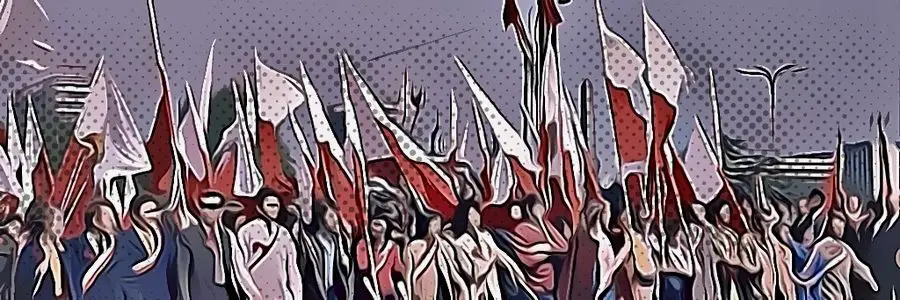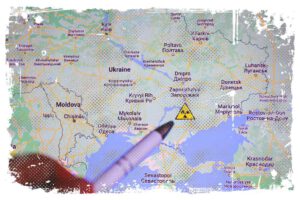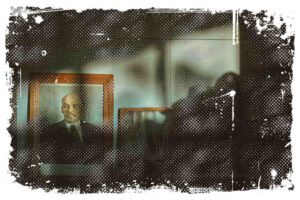During World War II and the Cold War, Poland flew a white and red flag. In 1921, the Ministry of Military Affairs released a brochure stating that the red color on the flag was crimson, but in 1928, the President changed it to cinnabar. Despite this change, both of these colors are shades of red, which is still considered part of the official flag.

Polish soldiers and the Polish Underground State both used white and red flags during World War II. These colors symbolized the bravery and sacrifices of the Polish military. They were flown in various locations, including Monte Cassino and Berlin. During the Cold War, it was illegal in Poland to display the national flag.
The Polish Underground State’s Flag During WWII
During World War II, the Polish Underground State was a secret organization that operated within occupied Poland. It was created on September 27, 1939, and called off on July 1, 1945. The Underground State was made up of different state organizations that acted on behalf of the Republic of Poland and was supported by the Polish Government in Exile.
It operated during the occupation of Polish territory by the Third Reich and the USSR. As shown in the image below, the Underground State’s flag was a white and red banner with an anchor symbolizing fighting Poland.

Death Penalty for Displaying the Flag
I need to explain you, that during World War II, displaying the Polish flag was a courageous act. Any resistance activity with the white and red colors or national emblem provided encouragement during these dangerous tasks. Printers in occupied Warsaw were the ones who distributed the flags and emblems. They knew that if they were caught, they would be sentenced to death.
On August 1, 1944, after the outbreak of the Warsaw Uprising, many residents of the capital city flew white and red flags. This was a demonstration of patriotism and a symbol of a free Poland.
“Seeing the sunlit streets adorned with Polish flags was a moment of complete euphoria,” Jan Ołdakowski said. Jan is Director of Warsaw Uprising Museum.
White and Red Flag on the Victory Column in Berlin in 1945
The 1st Tadeusz Kosciuszko Infantry Division was a formation that was created in 1943 and fought alongside the Red Army as part of the 1st Polish Army in the Battle of Berlin. It was under the complete command of the USSR, both politically and militarily. For Stalin, the existence of this division was used as justification for his plans to make Poland a Soviet satellite state.
Five volunteers
It was put up by five volunteers. One of whom was Mikolaj Troicki, the commander and initiator of the action. Troicki’s story reflects the complicated history of Poles in Eastern Europe during WWII. He started out fighting in the Polish Army at the Bzura River in September 1939, but after the defeat he joined the Home Army Union. Unfortunately, Troicki was later captured and deported to Yugoslavia for labor. He managed to escape and join Tito’s communist partisans, and when the Red Army occupied the Balkans, he returned to Poland to join the 1st Polish Army.
„We didn’t have a flag with us. We made it out of torn German quilts. We pinned it with whatever we had. However, there was no time to celebrate”
Mikolaj Troicki said
According to another version, the flag that was hung on the Victory Column in Berlin was actually made from the canvas of German parachutes that were used to drop supplies for Berliners during WWII.
A group of five soldiers climbed a high staircase to the top of the column, which had previously served as an observation post for the Nazis. They had to get through the destroyed telephone wires, ammunition boxes, and shell casings as they made their way to the top.
Once they reached the top, they used a cable to attach the flag to the hands of the angel statue that crowned the Victory Column. The Polish flag, was also hung on the train station and the Brandenburg Gate.
It was a brave move to hang the flag under such circumstances. The Germans were still fighting, and the sounds of enemy artillery could still be heard nearby. The park where the monument was located was still a battlefield.
Cold War in 1945-1980
During the communist period, the authorities removed the crown from the eagle’s head on the flag. It took place in 1944. On top of that, the red-and-white flag was only permitted to be flown on two days each year. May 2 was designated as a day for mass flag stripping. The communist government wanted to promote its own holiday, which was May 1. It was the only day permitted for the red and white to be flown so that it would not be flown on May 3, which was considered the anniversary of Poland’s independence. It was actually illegal to fly the red-and-white flag during this time under a 1955 law. If someone were caught doing so, they could be subject to even longer imprisonment, up to a year.
In 1989, there was an amendment to the Constitution that made a symbolic change by restoring the crown to the eagle on the flag. The white eagle on a red field is one of the most important symbols of the Republic of Poland, along with the flag and the anthem. The amendment removed provisions about the leadership role of the party and the friendship with the Soviet Union. It introduced new concepts such as freedom of economic activity, protection of property, and political pluralism.
Bibliography
- https://radiowarszawa.com.pl/oldakowski-w-czasie-okupacji-za-wywieszenie-flagi-grozila-kara-smierci/
- https://www.polskieradio.pl/39/156/Artykul/2502891,77-lat-temu-bialoczerwona-flaga-zawisla-na-Kolumnie-Zwyciestwa-w-Berlinie
- https://polska-zbrojna.pl/Mobile/ArticleShow/16544
- http://radio.opole.pl/100,195977,nie-zawsze-mozna-bylo-wywieszac-flage-w-czasach-




